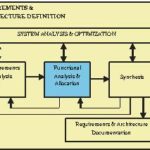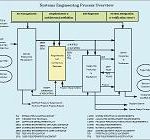

Support
Early Functional Analysis and Allocation in the System Engineering Process
Early Functional Analysis and Allocation in the System Engineering Process (Part 1)
All credible Testability and Diagnostic Analysis must be based upon an appropriate level of early functional analysis and allocation as identified in a system engineering process. Failure analysis data may be used to augment the functional analysis to provide additional fidelity. An excellent reference for detailed discussion of the system engineering process is James N. Martin’s book Systems Engineering Guidebook—A Process for Developing Systems and Products which is available through DSI. The figures below (based on Mr. Martin’s book), identify the top level system engineering processes. The “Requirements and Architecture” block shown below is where requirements definitions are analyzed and decomposed into functional elements. If necessary, functional allocations are made and assigned to lower level subsystems.
(Click to view larger image)
The diagram at the left shows some of the related data sharing and analysis interfaces that must occur with any functional analysis or allocation. Much of this process can be captured within the eXpress modeling and analysis environment and migrated (using eXpress data exchange capabilities) into other system engineering processes. This enables the data to be used and re-used without re-entry or loss of continuity throughout the life of the system. Following a system engineering process while performing testability and diagnostic analysis helps to provide a vision for how the information and data can be shared with other process supplier / customer interfaces. As a very wise man once said: “Where there is no vision, the people perish.” – Proverbs 29:18

In our next newsletter, we will go to the lower level “Functional Analysis & Allocation” and provide a brief overview of how this process is embodied within the eXpress environment.
Early Functional Analysis and Allocation in the System Engineering Process (Part 2)
In the last eXpress Newsletter, we provided an overview of the System Engineering Process and how diagnostic requirements are defined and integrated early in a program. The importance of early functional allocation and analysis can not be stressed enough. Prior to initiating Functional Analysis and Allocation, the requirements must be well defined and allocated. This task is represented in the very top source block in the diagram below labeled “Requirements Analysis”. eXpress can be a very useful tool in the requirements allocation task by developing a requirements allocation model, but that’s a topic for another newsletter.
In many situations, the Functional Analysis will identify or refine previously defined requirements and, therefore, a method to provide “feedback” into the process is necessary. In the lower left of the process flow below, you will notice that this “Requirements Feedback Loop” has been taken into account for within this sub process.
(Click to view larger image)
As the Functional Analysis begins, the analyst must define various attributes of the system such as System States and Modes, System Functions, and Functional Interfaces. The activity may periodically be influenced by design feedback and functional refinement feedback. These feedback inputs shouldn’t perturb the process but rather enhance the synergy necessary to flush out important system engineering/diagnostic issues.
Once the definition of key system elements are identified, an internal review provides the team with the opportunity to collaborate, refine, and verify that all functions and interfaces are identified.
For the eXpress user, these functions and interfaces are captured in the first steps of diagnostic model development by constructing the model topology, defining functional flow through use of dependencies, and creating states.
It is from the eXpress models that Functional Allocation can be performed. System operating modes can be captured for the analysis of various operational / maintenance scenarios, redundant hardware and multiple function paths accommodate availability requirement and Failure Modes and Effects data elements simulate potential critical failures. Testing and diagnostic alternatives are analyzed by the use of created test sets, tests, and diagnostic studies in the eXpress environment.
As allocations are examined, periodic adjustments are accounted byway of a FMEAloop which provides a mechanism to improve fault detection and recovery of the system design. All of these functional data elements and allocations are integrated into the eXpress modeling environment. As Functional Analyses are generated directly from the eXpress model, valuable feedback into requirements and functional definitions help to integrate the design for optimal diagnostic performance. This iterative process continues throughout the design phase but begins to taper off as potential design changes become less feasible. This is why it is important to begin this process early.
Models constructed for Functional Analysis and Allocation, can be transitioned to System Integration models and runtime host strategy and logic base for integrated vehicle health management (IVHM) systems. The TestBase program by TYX provides this bridge. Look for an IVHM demonstration system from DSI utilizing this real time capability in the next several months.




